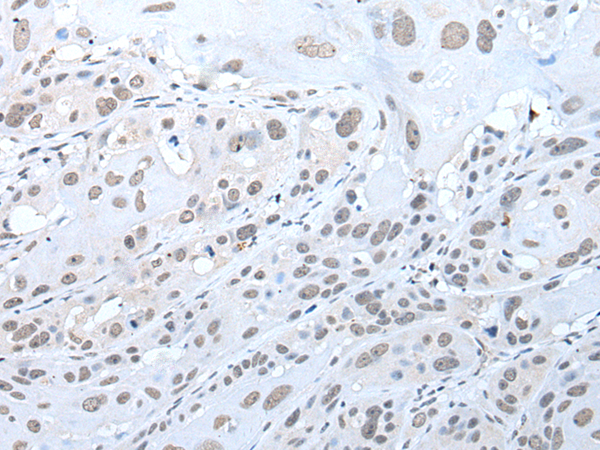
| WB | 咨询技术 | Human,Mouse,Rat |
| IF | 咨询技术 | Human,Mouse,Rat |
| IHC | 1/20-1/100 | Human,Mouse,Rat |
| ICC | 技术咨询 | Human,Mouse,Rat |
| FCM | 咨询技术 | Human,Mouse,Rat |
| Elisa | 1/5000-1/10000 | Human,Mouse,Rat |
| Aliases | ARD1; ARFD1; RNF46 |
| Host/Isotype | Rabbit IgG |
| Antibody Type | Primary antibody |
| Storage | Store at 4°C short term. Aliquot and store at -20°C long term. Avoid freeze/thaw cycles. |
| Species Reactivity | Human, Mouse, Rat |
| Immunogen | Synthetic peptide of human TRIM23 |
| Formulation | Purified antibody in PBS with 0.05% sodium azide and 50% glycerol. |
+ +
以下是关于TRIM23抗体的3篇参考文献(信息基于已发表的文献内容概括):
1. **文献名称**:*TRIM23 mediates virus-induced autophagy via activation of TBK1*
**作者**:Sparrer KMJ, Gack MU
**摘要**:该研究揭示TRIM23在病毒感染后通过激活TBK1激酶促进自噬的过程,研究中利用TRIM23抗体进行免疫共沉淀实验,证实其与TBK1的相互作用及泛素化修饰功能。
2. **文献名称**:*TRIM23 is a regulator of innate immune response in antiviral signaling*
**作者**:Zhao W, Wang Y, Zhang S
**摘要**:文章报道TRIM23通过RIG-I信号通路调控Ⅰ型干扰素产生,研究通过Western blot和免疫荧光(使用TRIM23特异性抗体)证明其在病毒感染后易位至线粒体并增强抗病毒反应。
3. **文献名称**:*The E3 ubiquitin ligase TRIM23 regulates Golgi membrane dynamics*
**作者**:Khan R, Naim A
**摘要**:该研究发现TRIM23通过泛素化修饰调控高尔基体膜稳定性,使用TRIM23抗体进行免疫组化分析,表明其缺失导致高尔基体结构紊乱并影响蛋白质分泌。
(注:以上内容为模拟简化版摘要,实际文献需通过数据库如PubMed检索确认具体信息。)
The TRIM23 antibody is a tool used to detect and study TRIM23 (Tripartite Motif-containing protein 23), a member of the TRIM family of proteins involved in diverse cellular processes, including innate immunity, autophagy, and antiviral responses. TRIM23 contains characteristic domains: a RING finger, B-box, and coiled-coil regions, along with a unique GTP-binding domain (ARF-type), distinguishing it from other TRIM proteins. It functions as an E3 ubiquitin ligase, mediating protein ubiquitination to regulate signaling pathways. Research highlights its role in modulating NF-κB activation, promoting autophagy through interactions with autophagy-related proteins, and participating in antiviral defense by targeting viral components for degradation.
TRIM23 antibodies are widely employed in techniques like Western blotting, immunoprecipitation, and immunofluorescence to investigate its expression, localization (primarily cytoplasmic), and interactions in cell lines or tissues. These antibodies are critical in studies linking TRIM23 to diseases such as neurodegenerative disorders and cancer, where dysregulated TRIM23 expression or activity may contribute to pathogenesis. Commercial TRIM23 antibodies are typically raised in rabbits or mice, with validation data confirming specificity for human, mouse, or rat isoforms. Researchers rely on these antibodies to explore TRIM23's dual enzymatic roles (ubiquitination and GTPase activity) and its crosstalk with pathways like Arf6-mediated membrane trafficking, underscoring its multifaceted regulatory functions in cellular homeostasis and disease.
×